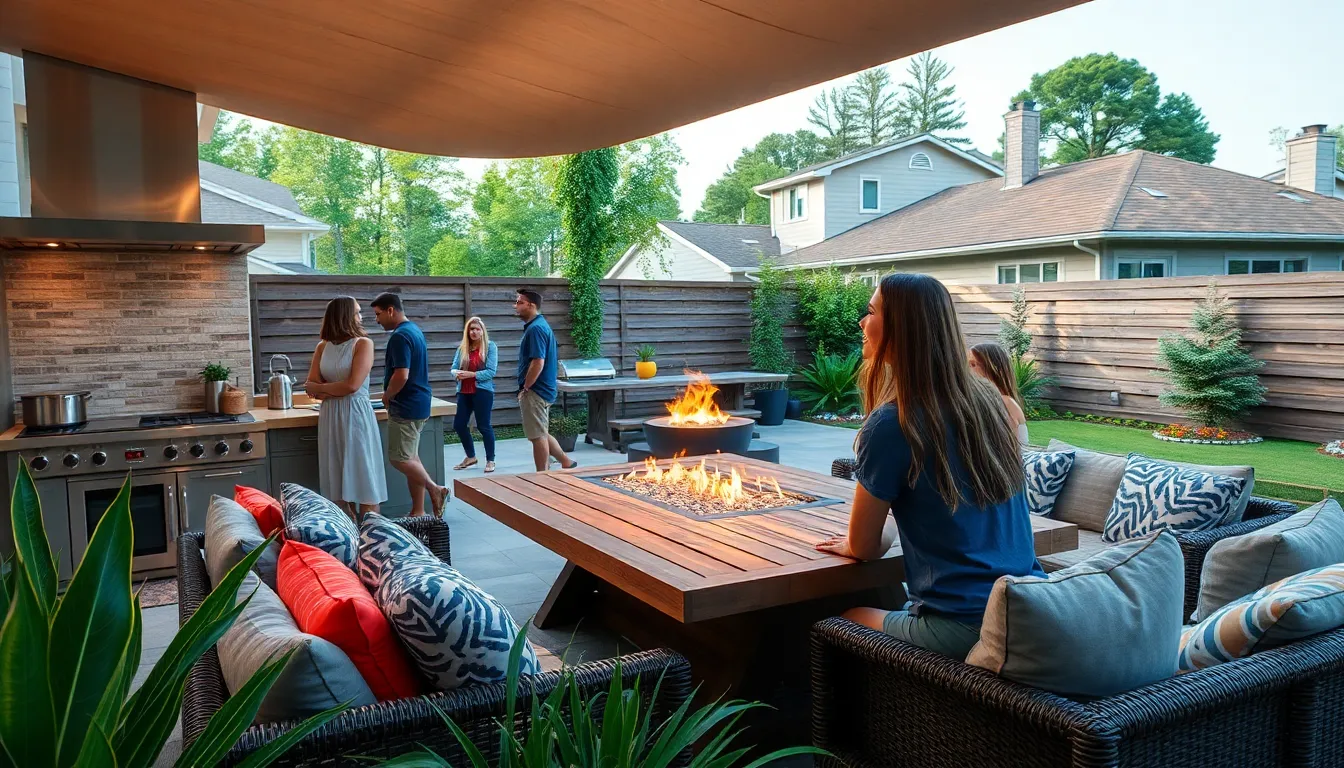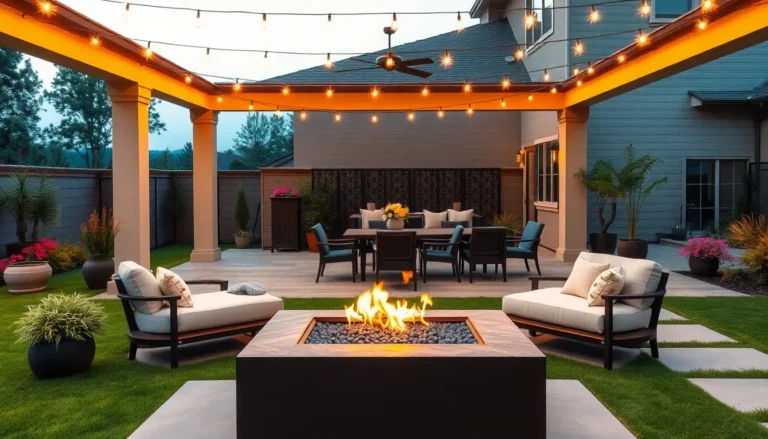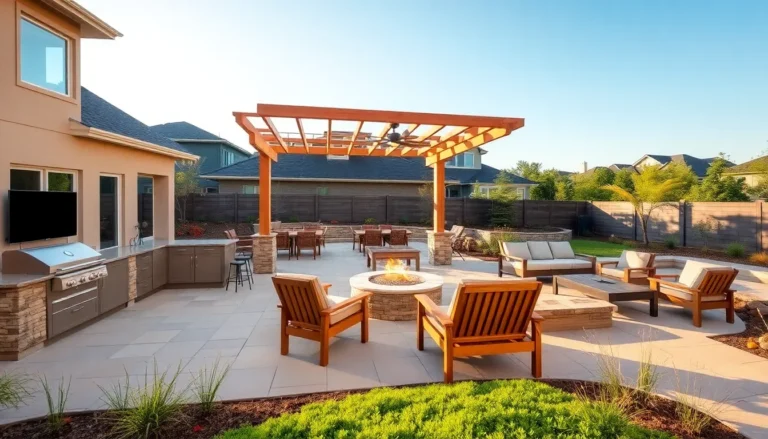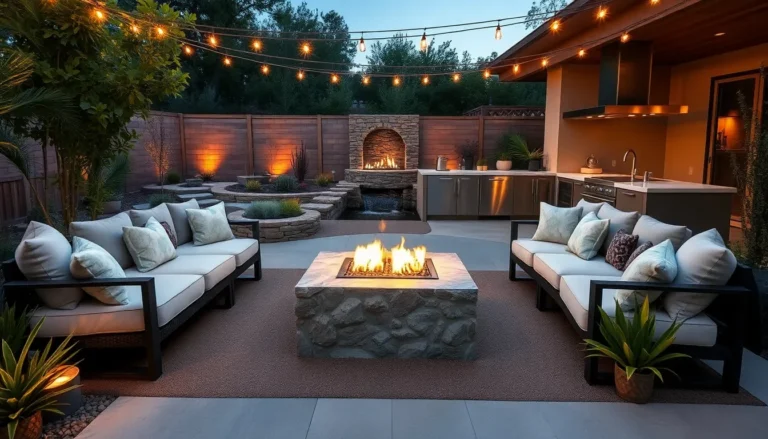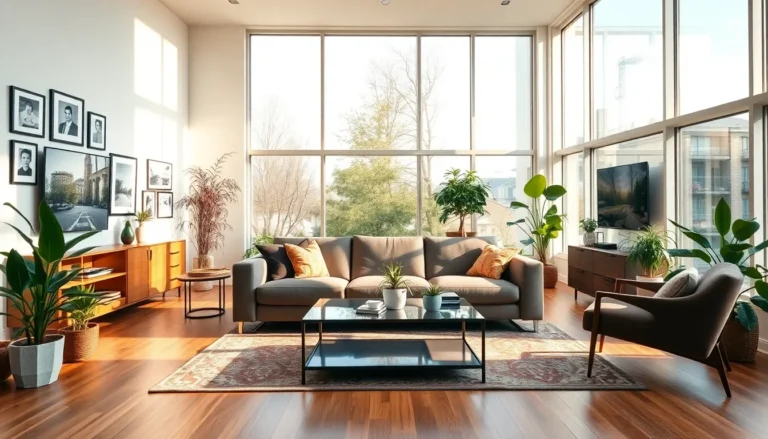Table of Contents
ToggleAs the world spins towards 2025, outdoor living is set to become the hottest ticket in town—literally! Gone are the days when patios were mere afterthoughts. Today’s outdoor spaces are evolving into extensions of our homes, where style meets functionality and relaxation reigns supreme. Imagine sipping your morning coffee in a chic lounge chair while surrounded by lush greenery. Sounds dreamy, right?
Overview of Outdoor Living Trends
Outdoor living trends for 2025 emphasize stylish and functional spaces that extend the home. A primary focus is on creating inviting areas for relaxation and socialization. Homeowners seek to merge comfort with nature, expanding outdoor rooms to include dining spaces, lounges, and kitchens.
Innovative materials gain popularity, like weather-resistant fabrics and sustainable wood alternatives. These materials enhance aesthetics while ensuring durability. Smart technology increasingly integrates into outdoor spaces, allowing automated lighting, sound systems, and climate control.
Natural elements significantly influence design choices. Plants, water features, and organic textures help create a serene atmosphere. Incorporating biophilic design fosters a stronger connection between indoors and outdoors.
Functionality plays a crucial role in modern landscaping. Modular furniture allows for flexibility in space utilization, enabling easy reconfiguration for gatherings or quiet moments. Enhancements, such as fire pits and outdoor heaters, extend usability into cooler months.
Color palettes evolve toward earth tones and soft greens. These colors harmonize with surrounding environments, promoting tranquility. Unique features, like vertical gardens or outdoor art installations, make outdoor spaces more personalized.
Accessibility remains vital, ensuring all individuals can enjoy outdoor areas. Pathways and barriers are designed to enhance mobility while maintaining aesthetic appeal. As outdoor living habits continue to shift, community spaces increasingly showcase gardens and recreational areas, encouraging outdoor interaction.
Overall, the outdoor living trends for 2025 reflect a commitment to comfort, technology, sustainability, and personalization. These elements transform outdoor spaces into essential extensions of the home, fostering relaxation and enjoyment.
Sustainable Outdoor Spaces
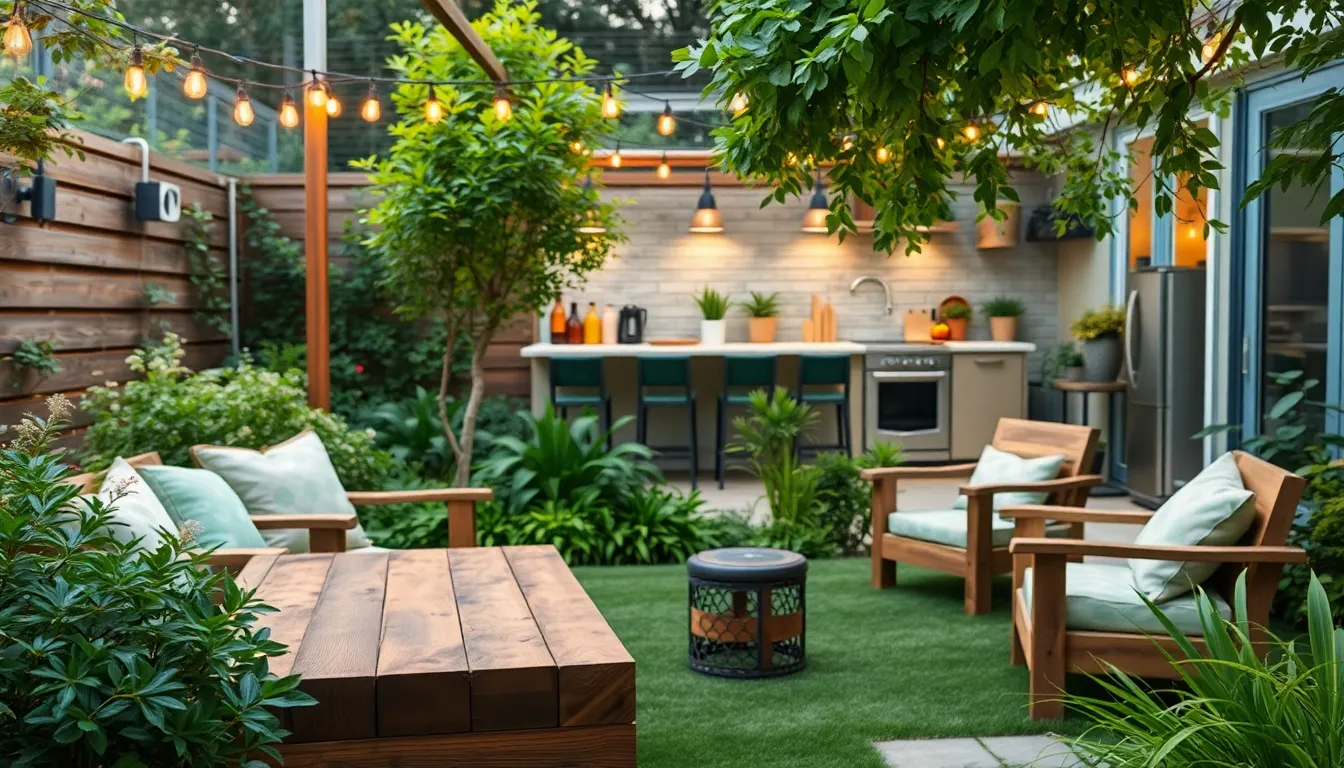
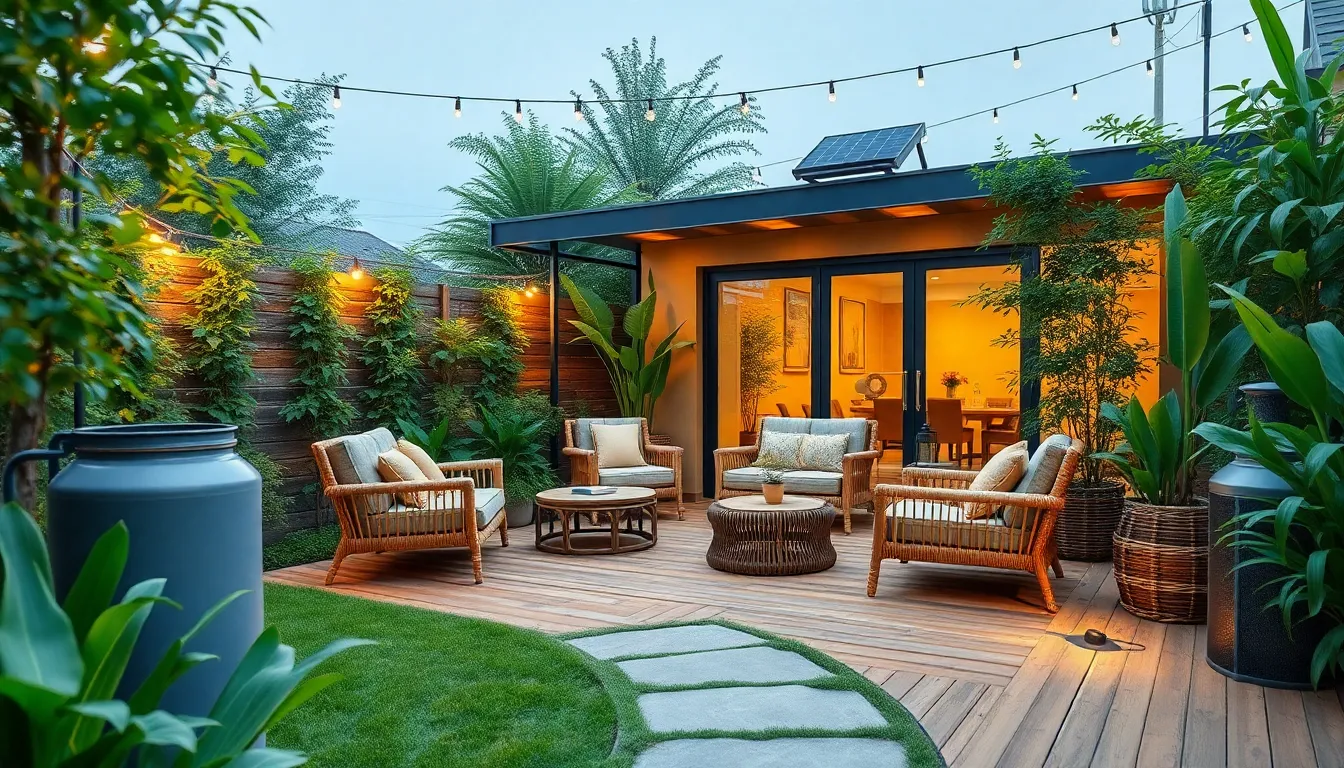
Sustainability shapes outdoor living trends for 2025, leading to a focus on eco-friendly designs. Homeowners increasingly seek materials and practices that minimize environmental impact.
Eco-Friendly Materials
Natural materials like bamboo and reclaimed wood emerge as popular choices. These resources not only reduce deforestation but also provide a unique aesthetic appeal. Composite decking, made from recycled materials, offers durability and low maintenance. Additionally, manufacturers create outdoor furniture from sustainably sourced fabrics, reducing reliance on petroleum-based products. This conscious selection reflects a significant shift towards creating spaces that honor nature.
Energy-Efficient Features
Incorporating energy-efficient features enhances outdoor areas while conserving resources. Solar-powered lights illuminate pathways and patios, reducing electricity costs and promoting sustainability. Rainwater harvesting systems provide irrigation for gardens, reducing reliance on municipal water supplies. Smart thermostats and automated shading devices conserve energy by optimizing temperature control. Investments in energy-efficient appliances for outdoor kitchens support responsible resource usage. Each of these features underscores a commitment to environmental stewardship in outdoor living spaces.
Smart Outdoor Living
Smart outdoor living incorporates technology to enhance experiences. Innovations streamline outdoor enjoyment while promoting convenience.
Innovative Technologies
Smart lighting systems automatically adjust brightness based on surroundings. Automated irrigation systems ensure gardens receive optimal moisture without effort. Voice-controlled speakers provide customizable soundscapes, complementing outdoor gatherings. Weatherproof displays allow users to watch outdoor movies or check the weather seamlessly. Homeowners embrace technologies that enhance relaxation and interaction in outdoor spaces.
Integrated Home Systems
Integrated home systems connect outdoor environments to indoor living. Homeowners operate everything from lighting to entertainment through smartphones or voice commands. Rain sensors can trigger irrigation systems, conserving resources while maintaining gardens. Energy-efficient smart thermostats regulate heating and cooling, ensuring comfort in adjacent indoor spaces. Such systems create a cohesive living experience, effortlessly merging outdoor and indoor life.
Outdoor Aesthetics and Design
Outdoor aesthetics and design trends for 2025 emphasize harmony and comfort. Homeowners seek to create visually appealing spaces that blend seamlessly with nature.
Color Trends for 2025
Earth tones dominate color palettes, reflecting an appreciation for natural environments. Shades of deep greens, warm browns, and muted neutrals create calming atmospheres. Soft, pastel colors emerge in textiles and accents, providing subtle contrast against lush greenery. Homeowners incorporate bold hues in accessories to energize spaces without overwhelming them. This balanced approach encourages outdoor areas to feel inviting and cohesive.
Popular Furnishing Styles
Sustainability influences furnishing styles significantly. Modular furniture gains traction for its versatility and adaptability to varying space needs. Rustic designs featuring reclaimed wood resonate with many, promoting eco-friendly choices. Minimalist aesthetics also rise, focusing on clean lines and functional forms. Comfortable seating arrangements encourage social interaction, allowing for relaxed gatherings. These styles reflect a commitment to both form and function in outdoor living spaces.
Expanding Functional Spaces
Expanding outdoor functional spaces reflects homeowners’ desire for versatility and comfort. Transformations make outdoor areas suitable for various activities, enhancing usability.
Multi-Use Areas
Flexibility defines multi-use areas, allowing space for relaxation, dining, and entertainment. Homeowners design patios to accommodate a range of activities. Creative layouts integrate seating arrangements, fire pits, and game stations within one cohesive space. Multi-purpose furniture, such as storage benches or collapsible tables, contribute to this adaptability, making transitions seamless. Incorporating shade structures also adds comfort, ensuring enjoyable outdoor experiences throughout different seasons.
Outdoor Kitchens and Dining
Outdoor kitchens and dining areas emerge as central features in modern outdoor living. These spaces often include built-in grills, refrigerators, and sinks to streamline meal preparation. Homeowners favor designs that facilitate cooking and dining under the stars. Dining spaces equipped with comfortable seating attract family gatherings, while attractive lighting enhances ambiance. Additionally, weather-resistant materials ensure lasting durability, reflecting the commitment to quality and style in outdoor aesthetics. Combining functionality with elegant design makes these kitchens extensions of the indoor culinary experience.
As outdoor living trends evolve into 2025, homeowners are embracing the idea of transforming their outdoor spaces into functional and inviting extensions of their homes. The focus on comfort and socialization is reshaping patios and gardens into areas that foster connection and relaxation.
Sustainability remains a core principle guiding these trends with eco-friendly materials and energy-efficient features becoming standard. The integration of smart technology enhances convenience and enjoyment while creating seamless indoor-outdoor living experiences.
With an emphasis on natural aesthetics and versatile designs, outdoor spaces are set to reflect personal style and environmental consciousness. As these trends take shape, they promise to redefine how individuals interact with their outdoor environments, making them essential for modern living.

